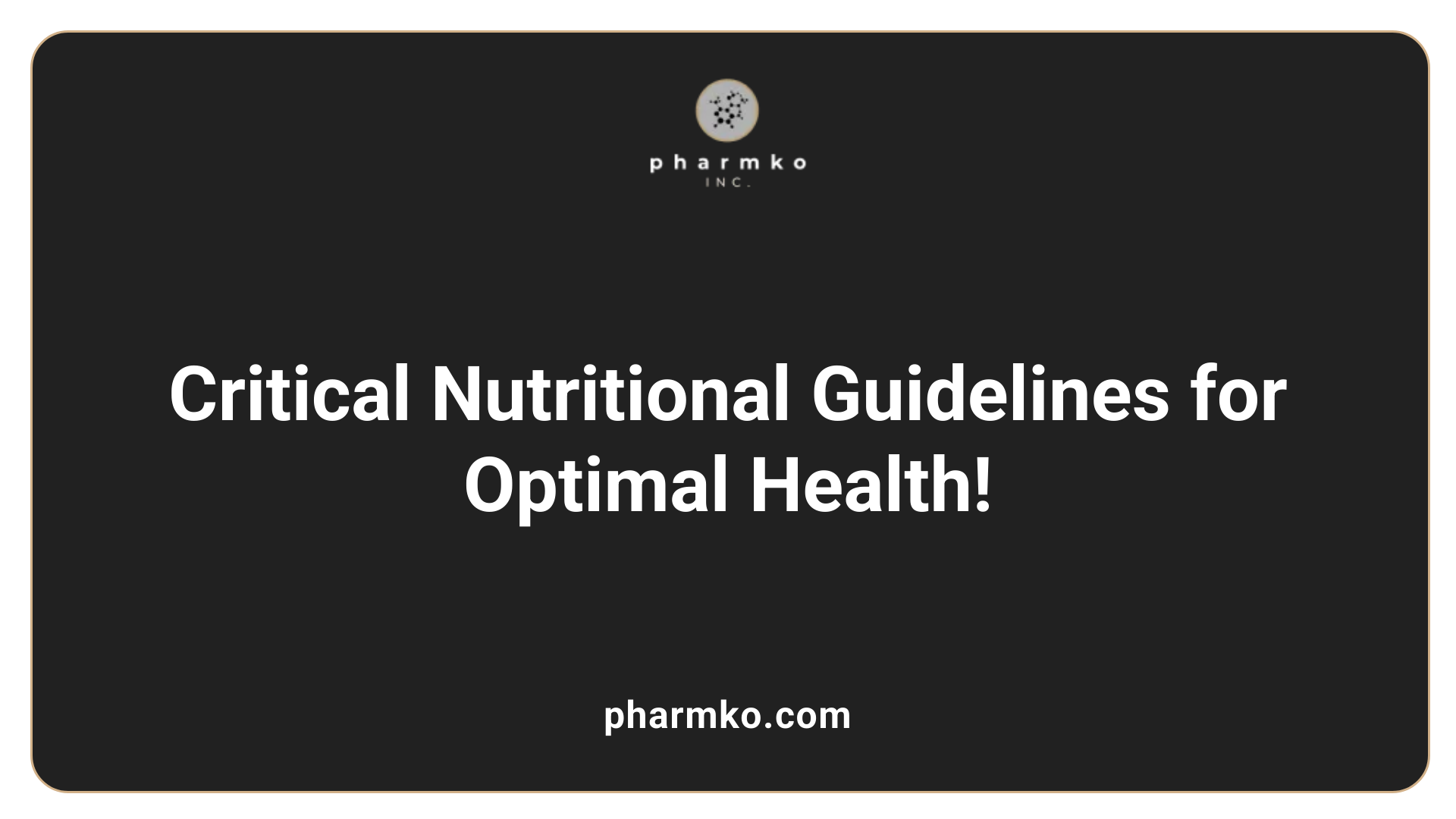How IDPN Helps Maintain Nutritional Status in Hemodialysis Patients

Introduction to IDPN
Intradialytic Parenteral Nutrition (IDPN) offers a promising approach for addressing malnutrition in hemodialysis patients. Despite its potential advantages, its role remains nuanced amid conflicting evidence on its effectiveness compared to traditional nutritional strategies. This article delves into the mechanisms, implications, and clinical outcomes of IDPN in managing nutritional needs in this vulnerable patient population.
Understanding IDPN in Dialysis Context

What is IDPN nutrition for dialysis patients?
Intradialytic parenteral nutrition (IDPN) is a specialized form of supplementation for patients undergoing hemodialysis. It entails the intravenous delivery of essential nutrients directly into the bloodstream during dialysis sessions, primarily utilizing an infusion pump to ensure a steady supply. This approach is particularly valuable for those suffering from malnutrition or at risk of undernutrition when standard interventions like dietary counseling and oral nutritional supplements fall short.
Purpose in hemodialysis
IDPN serves several crucial functions:
- Addressing Nutritional Deficits: By supplying calories and protein, IDPN helps counteract the effects of protein-energy wasting (PEW), which affects a significant percentage of hemodialysis patients.
- Mitigating Dialysis Impact: It aims to alleviate nutrient losses that can occur due to the hemodialysis process itself, thus helping to maintain and improve a patient’s overall health status.
- Evaluating Efficacy: Regular monitoring of patients receiving IDPN allows healthcare providers to assess its effectiveness in enhancing nutritional markers, such as serum albumin levels, which are critical indicators of patient health.
Nutritional benefits
IDPN has shown promising results in specific clinical parameters:
- Serum Albumin Improvement: Studies indicate noteworthy increases in serum albumin levels among patients on IDPN, suggesting enhanced nutritional status.
- Weight Maintenance: Patients receiving IDPN may experience better weight management and possibly increased muscle mass, both essential for individuals undergoing ongoing dialysis treatment.
- Reduced Hospitalizations: There are indications that utilizing IDPN could lead to decreased hospitalization rates associated with malnutrition-related complications.
Overall, while IDPN is not a comprehensive solution and cannot replace oral intake, it plays a vital role in supplementing nutrition for hemodialysis patients who cannot meet their dietary needs through traditional means alone.
Key Nutritional Guidelines for Hemodialysis Patients

What are the nutritional guidelines for patients on hemodialysis?
Patients on hemodialysis must adhere to specific nutritional guidelines to maintain their health. One of the foremost considerations is high-protein intake. Due to protein loss during dialysis, these patients typically need more dietary protein than non-dialysis individuals. It's suggested that patients should aim for at least 1.2 grams of protein per kilogram of body weight daily to help prevent malnutrition.
In addition to protein, there are fluid and mineral restrictions that patients must follow. Sodium, potassium, and phosphorus intake should be limited to avoid complications such as hypertension and hyperkalemia. Fluid restrictions are particularly critical and usually depend on the individual’s urine output. For example, those undergoing in-center dialysis may have stricter limits compared to patients on home dialysis.
A renowned renal dietitian plays a crucial role in managing these dietary needs. They will tailor recommendations based on lab results and personal health requirements, ensuring a well-balanced diet that includes adequate protein, calories, and essential nutrients. Regular monitoring through blood tests helps assess the effectiveness of the dietary plan and dialysis treatment, leading to timely adjustments to optimize patient care.
Implementing Effective Nutritional Strategies

What are the nutritional considerations for patients on dialysis?
Patients on dialysis for end-stage renal disease must drastically modify their diet to satisfy new nutritional requirements. A crucial aspect of managing their condition involves increasing protein intake from high-quality sources like:
- Lean meats
- Poultry
- Fish
- Eggs
- Dairy products
- Beans and lentils
- Nuts and tofu
Alongside protein, it is vital to manage levels of salt, fluids, potassium, and phosphorus. Here are some important dietary recommendations:
- Limit Salt: Choose low-sodium options to help control blood pressure.
- Control Fluid Intake: Monitor and restrict fluid consumption to reduce the risk of overload during dialysis.
- Potassium Awareness: Opt for low-potassium fruits and vegetables and avoid high-potassium foods, such as bananas and potatoes.
- Phosphorus Management: Careful monitoring is essential. Limit intake of nuts, seeds, and foods with phosphate additives.
Consulting with a registered dietitian who specializes in kidney disease can play a pivotal role in tailoring a meal plan that fulfills these nutritional goals. Regular follow-ups with healthcare professionals ensure that dietary adjustments remain effective and beneficial for each individual's health needs.
Comparing IDPN and Total Parenteral Nutrition
How does IDPN differ from Total Parenteral Nutrition (TPN)?
IDPN (Intradialytic Parenteral Nutrition) and Total Parenteral Nutrition (TPN) both serve as nutritional support strategies, yet they cater to distinct patient needs based on their medical conditions and treatment contexts.
Purpose and Timing:
- IDPN: Administered during hemodialysis sessions specifically for patients unable to meet their nutrition through standard oral means. It primarily aims to supplement nutrients to address malnutrition and combat the potential protein-energy wasting (PEW) syndrome prevalent among dialysis patients.
- TPN: Delivers complete nutrition intravenously and is used independently when patients cannot consume any oral food due to medical conditions that severely limit their dietary intake.
Nutritional Coverage:
- IDPN: Offers partial nutrition and is intended only as a supplementary measure; it requires a concurrent attempt at dietary counseling and oral nutrition supplementation. It typically provides macronutrients—proteins, carbs, and fats—through the bloodstream during dialysis.
- TPN: Provides total nutrition, ensuring all macro and micronutrient requirements are met continuously, often for patients who need complete dietary support for an extended period.
Clinical Outcomes: While IDPN is beneficial within the confines of dialysis with some evidence of short-term improvements in nutritional markers (like serum albumin), it has not consistently shown long-term benefits compared to traditional oral supplements or dietary counseling strategies. In contrast, TPN might be medically necessary for individuals with severe deficiencies and has specific criteria that allow for its implementation as a life-sustaining treatment.
In summary, whereas IDPN facilitates nutrition supplementation during dialysis, TPN is critical for total nutritional replenishment in patients who require ongoing support, making them suitable for different clinical situations.
Administration of IDPN in Hemodialysis
How is IDPN administered during hemodialysis?
IDPN (Intradialytic Parenteral Nutrition) is intricately integrated into the hemodialysis process. The infusion occurs via the venous drip chamber, utilizing an infusion pump to ensure a steady delivery of nutrients. Typically administered at the onset of a 4-hour hemodialysis session, it is channeled into the venous line distal to the dialyzer, guaranteeing that nutrients are effectively delivered into the bloodstream.
Registered nurses (RNs) trained specifically in hemodialysis oversee the initiation and continual monitoring of IDPN therapy. In contrast, Licensed Practical Nurses (LPNs) are not authorized to manage this infusion. Initial IDPN flow rates often start at 125 mL/hour, which can be adjusted based on individual patient requirements and their tolerance levels.
Monitoring during IDPN therapy
Monitoring during IDPN is critical to ensure patient safety and treatment efficacy. The clinical team closely monitors blood glucose levels throughout the hemodialysis session. This vigilance helps prevent complications such as hyperglycemia or electrolyte imbalances that might arise from IDPN administration. Regular assessments allow healthcare providers to modify infusion rates and nutrient compositions, offering a tailored approach to each patient's nutritional needs.
Role of healthcare staff
The delivery and monitoring of IDPN are collaborative efforts among healthcare staff. Besides RNs, dietitians play a key role in assessing nutritional status and determining suitable dietary interventions alongside IDPN. By regularly reviewing each patient's progress, healthcare providers can effectively manage malnutrition risks, ensuring patients receive the support they need for optimal health outcomes.
Potential Side Effects and Risks of IDPN

What are the potential side effects of using IDPN in hemodialysis?
While Intradialytic Parenteral Nutrition (IDPN) is considered a safe nutritional strategy for hemodialysis patients, it is not without its potential side effects. The complications associated with IDPN tend to be minimal, but can still present challenges for some patients.
- Gastrointestinal Symptoms: Some patients may experience nausea, vomiting, or diarrhea. These symptoms are often manageable by adjusting the infusion rate of IDPN.
- Flushing Reactions: Generalized flushing may occur, which can typically be alleviated through careful titration of the infusion formulation.
- Hyperglycemia: Diabetic patients, in particular, are at risk for elevated blood sugar levels as a result of the dextrose content in IDPN.
- Liver Concerns: There are potential risks for fatty liver and hypertriglyceridemia if not monitored properly.
Despite these risks, studies indicate that IDPN has a favorable safety profile. In clinical trials, no significant increase in adverse symptoms has been reported when compared to control groups, making it a viable option for patients who cannot tolerate oral nutritional supplements. Monitoring and adjusting the treatment as needed can help mitigate these potential complications effectively.
How to manage side effects?
Management of side effects involves regular monitoring of the patient's response to IDPN therapy. This includes:
- Adjusting infusion rates to alleviate gastrointestinal symptoms.
- Monitoring blood glucose levels in diabetic patients.
- Routinely checking liver function tests to identify any early signs of liver dysfunction.
The clinical team, particularly dietitians and pharmacists, plays a crucial role in overseeing the patient's nutritional status and therapy efficacy, allowing timely interventions if complications arise.
Role of IDPN in Nutritional Outcomes
What is the role of IDPN in improving nutritional outcomes for hemodialysis patients?
IDPN, or intradialytic parenteral nutrition, is essential for enhancing nutritional outcomes in hemodialysis patients. This therapy involves providing necessary nutrients directly during dialysis sessions, which is particularly beneficial for individuals facing difficulties with oral nutritional intake. Patients with chronic kidney disease may experience appetite loss or may not consume sufficient nutrients, leading to malnutrition, a significant predictor of increased morbidity and mortality within this population.
Impact on nutritional health
Clinical evidence shows that IDPN can help maintain protein-energy balance in patients who either cannot consume enough food or are unable to tolerate oral nutritional supplements. Some studies have indicated improvements in nutritional markers, such as serum albumin and body mass index, after administering IDPN. For instance, a randomized controlled trial revealed that serum albumin levels increased significantly in patients receiving IDPN, with outcomes suggesting better nutritional status after the intervention.
Comparisons with other methods
Despite these improvements, IDPN does not appear to surpass conventional methods such as dietary counseling or oral nutritional supplements in terms of overall patient health and clinical outcomes. Guidelines suggest IDPN should only be considered when standard nutritional approaches have been unsuccessful. Moreover, while it provides immediate nutritional support, IDPN does not typically result in long-term advantages in survival rates or reduced hospitalizations compared to oral counterparts.
Clinical trials
In line with emerging evidence, IDPN should be viewed as an adjunctive nutritional strategy, utilized particularly for those who cannot adequately meet their nutritional needs through oral means alone. The clinical pathway for using IDPN necessitates a thorough assessment of nutritional status, highlighting the importance of personalized patient care. Current research indicates that continued investigation and robust clinical trials are warranted to better understand IDPN's efficacy and long-term benefits in this high-risk group.
Nutritional Therapy in Hemodialysis
What is the purpose of nutritional therapy for patients receiving hemodialysis?
The purpose of nutritional therapy for hemodialysis patients is multi-faceted. It aims to enhance overall health and optimize the efficacy of dialysis treatment while managing complications arising from chronic kidney disease (CKD). A carefully controlled diet can significantly reduce waste buildup in the blood that may occur in between dialysis sessions.
Nutritional strategies help support the management of fluid balance, critical for preventing conditions like swelling and high blood pressure. Specific dietary restrictions are often necessary, with limits imposed on sodium, potassium, and phosphorus intake. This approach helps avert additional health complications while ensuring patients receive adequate protein and caloric intake.
Dietary management
Protein intake is particularly crucial; patients on hemodialysis often require about 1.2 grams of protein per kilogram of body weight daily. A renal dietitian plays a key role in crafting individualized meal plans tailored to each patient's unique medical requirements. These plans must strike a balance by maintaining adequate energy and nutrition levels to promote overall well-being.
Patient-specific adjustments
Moreover, ongoing assessment and monitoring are essential to adapt the nutritional plan according to the patient’s changing health status. With interventions such as IDPN (Intradialytic Parenteral Nutrition), healthcare professionals can provide additional support when oral intake is insufficient. The individualized nature of nutritional therapy is vital, as each patient's needs can vary significantly based on their dialysis regimen and underlying health conditions.
This comprehensive nutritional approach is critical for improving the quality of life for patients undergoing hemodialysis and effectively managing the effects of kidney disease.
Guidelines for Implementing IDPN
What are the current guidelines and recommendations for implementing IDPN in hemodialysis treatment?
Current guidelines highlight the importance of Intradialytic Parenteral Nutrition (IDPN) for hemodialysis patients who are malnourished and unable to meet their nutritional needs through oral or enteral means. According to the National Kidney Foundation recommendations, these patients should receive at least 1.2 g of protein per kg of body weight daily. IDPN is viewed as a necessary supplement to dietary efforts and is considered only after other interventions, like nutritional counseling and oral supplementation, have proven ineffective.
IDPN is uniquely administered during dialysis sessions, which allows for the infusion of essential nutrients directly into the bloodstream. It's designed to address the nutrient loss experienced during dialysis and combat malnutrition by offering a maximum of 25% of a patient's daily caloric or nutritional needs.
How should IDPN be monitored and evaluated?
Monitoring during IDPN therapy is critical to ensure patient safety and efficacy of treatment. Healthcare teams must track various nutritional parameters, including:
- Body weight
- Serum albumin levels
- Malnutrition-inflammation scores (MIS)
Regular assessments allow for timely adjustments to nutrition plans, ensuring that any potential complications, such as hyperglycemia or electrolyte imbalances, are properly managed.
What considerations should be made for patient safety?
While IDPN can offer significant benefits for malnourished patients, it does carry potential risks, including:
- Infections due to intravenous administration
- Fluid overload from additional fluids administered during sessions
- Chemical imbalances that may arise from nutrient infusions
Therefore, it is essential to approach IDPN usage cautiously, especially since current evidence does not consistently demonstrate improvements in long-term mortality or quality of life compared to standard treatments. A clear individualized nutritional approach is imperative, prioritizing safety while striving to enhance nutritional outcomes.
Challenges and Limitations of IDPN
Clinical challenges
One significant challenge with Intradialytic Parenteral Nutrition (IDPN) is its mixed outcomes regarding patient health. While some studies highlight individualized improvements, such as increased serum albumin and decreased malnutrition scores, others show that IDPN does not lead to long-term enhancements in patient health, mortality, or hospitalization rates when compared to standard nutritional strategies. Its efficacy can vary based on patient selection and adherence to the treatment plan, underlining the need for thorough clinical assessments before initiation.
Financial considerations
The cost of IDPN therapy poses another obstacle. Compared to oral nutritional supplements and dietary counseling, IDPN is considerably more expensive. Patients and healthcare systems may face financial burdens that can make IDPN less accessible as an option, especially when conventional methods are often effective. This high cost raises important questions about resource allocation and whether the benefits justify the investments for specific patient populations.
Long-term efficacy doubts
The long-term efficacy of IDPN remains an area of contention in the medical community. Current evidence, largely from randomized controlled trials, indicates that while IDPN may temporarily improve some clinical markers, it lacks robust data supporting sustained benefits. This uncertainty necessitates more extensive long-term studies to evaluate IDPN’s role effectively in improving mortality and quality of life outcomes among hemodialysis patients, making it imperative for healthcare providers to weigh the risks against potential benefits thoroughly.
Research Insights on IDPN Effectiveness
Clinical Trials Outcomes
Research has been pivotal in assessing the effectiveness of intradialytic parenteral nutrition (IDPN). Though some studies indicate that IDPN can enhance certain clinical parameters such as serum albumin levels—showing an increase from 3.5 g/dL to 3.8 g/dL—overall, IDPN has not demonstrated improved long-term patient outcomes, like reduced hospitalization rates or lower mortality, compared to traditional methods such as oral supplements.
Evaluation Criteria
The evaluation for IDPN suitability is based on specific malnutrition criteria including a serum albumin level below 3.2 g/dL and the patient's inability to tolerate adequate oral nutrition. This careful selection process ensures that IDPN is considered only after oral nutritional interventions have failed, thus aiming to mitigate any unnecessary risks or complications associated with its administration.
Comparative Studies
Numerous studies reveal that IDPN does not significantly outperform oral nutritional supplements or dietary counseling. A notable finding from randomized controlled trials shows that while IDPN can improve short-term nutritional markers like pre-albumin and protein intake, it lacks substantial clinical advantages for long-term health outcomes. This insight urges a more nuanced approach to nutrition management in hemodialysis patients, emphasizing the need for enhanced dietary counseling before resorting to IDPN.
| Study Focus | Findings | Conclusion |
|---|---|---|
| Serum Albumin Levels | Increased in IDPN group vs control | Short-term benefits noted |
| Long-term Outcomes | No significant differences in mortality or hospitalization rates | IDPN is not superior to standard care |
| Patient Eligibility | Serum albumin < 3.2 g/dL and inability to tolerate oral intake | Strict criteria for patient selection |
The Advancements and Future of IDPN

Emerging Technologies in IDPN Administration
Recent advancements in IDPN are centered around improving nutrient delivery methods. Innovations in intravenous systems and smart infusion pumps are enabling more precise control over nutrient composition and schedule, which could enhance the effectiveness of IDPN treatments. Research is also looking into personalized nutrition solutions that adapt to individual patient needs based on their metabolic responses and dialysis sessions.
Potential Improvements in Patient Outcomes
Future enhancements aim to synergize IDPN with other nutritional approaches. For instance, combining IDPN with oral nutritional supplements might yield better outcomes than either strategy alone. Studies are underway to explore how tailored macronutrient profiles could further mitigate malnutrition effects, aiding in recovery and maintaining quality of life for hemodialysis patients.
Ongoing Studies and Research Directions
Researchers are conducting long-term trials to track the impact of IDPN on overall morbidity and mortality in patients with end-stage renal disease. These investigations will help assess IDPN's role more definitively in enhancing survival rates, reducing hospitalizations, and improving metabolic profiles compared to traditional dietary interventions.
In conclusion, the future of IDPN in dialysis treatment looks promising, particularly with the integration of new technologies and research findings aimed at refining patient management and outcomes.
Holistic Approach to Nutritional Care in Dialysis
Integrative Care Models
Integrative care models for dialysis patients focus on the comprehensive management of malnutrition through collaboration between healthcare professionals. These include nephrologists, dietitians, and nurses working together to devise tailored nutrition plans that address individual patient needs.
Patient-Centered Strategies
A patient-centered approach incorporates the preferences and values of patients into their care plan, ensuring that interventions like Intradialytic Parenteral Nutrition (IDPN) are considered only after assessing dietary counseling effectiveness. This strategy ensures active patient involvement in their nutritional decision-making process.
Comprehensive Care Plans
Implementing comprehensive care plans involves regular monitoring and adjustments based on the patient's response to nutritional therapies. These plans often include the use of IDPN as a supplemental strategy while aiming to meet daily protein and calorie requirements through oral intake whenever possible. Nutritional assessments should inform ongoing revisions to enhance health outcomes, focusing on improving key parameters like serum albumin and overall quality of life.
| Care Aspects | Integrative Methods | Outcomes |
|---|---|---|
| Team Collaboration | Nephrologists, Dietitians | Personalized Nutrition Plans |
| Patient Engagement | Involving Patient Preferences | Increased Satisfaction |
| Monitoring | Regular Nutritional Assessments | Better Health Outcomes |
| Safety Measures | Careful Nutritional Planning | Reduced Complications |
Balancing IDPN and Conventional Nutritional Approaches
IDPN represents a critical option for addressing malnutrition in hemodialysis patients, particularly when conventional dietary strategies fail. While it offers significant benefits, it does not replace the need for a comprehensive dietary plan tailored to each patient's specific needs. The ultimate goal is to enhance patient outcomes through integrative care, leveraging a combination of traditional and novel methods. As research continues to evolve, IDPN's role may expand, further refining its use and reinforcing its place in the continuum of renal nutrition strategies.
References
- Evidence Brief: Use of Intradialytic Parenteral Nutrition (IDPN ... - NCBI
- [PDF] Intradialytic Parenteral Nutrition (IDPN) - BC Renal
- A roadmap for implementing a successful clinical experience with ...
- The beneficial effects of intradialytic parenteral nutrition in ... - Nature
- A roadmap for implementing a successful clinical experience with ...
- Intradialytic Parenteral Nutrition | Providers - Blue Cross NC
- IDPN/IPN - Pentec Health
- [PDF] The Use of Intradialytic Parenteral Nutrition in Hemodialysis Patients
- Intradialytic Parenteral Nutrition in Pediatrics - Frontiers
- Intradialytic parenteral nutrition for patients on hemodialysis


































































































